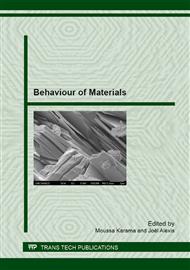p.49
p.57
p.63
p.71
p.79
p.85
p.91
p.99
p.107
Rheological Study of Composite Materials Based on Thermosetting Matrix and Fillers Mineral
Abstract:
In the development of composites materials, the matrix acts as a binder of different reinforcements can distribute the stress, provide good resistance to chemical structure and the desired shape to the final product. But there are still some drawbacks that arise in the physicochemical and mechanical properties of thermosetting matrices. Our job is to synthesize composite materials with news formulations of thermosetting matrices (Granitex products) by the incorporation of 40% of local mineral fillers. The latter give the matrix properties which it does not have, first, to reduce the cost of composite materials, and secondly, to improve implementation by increasing the viscosity and reducing the withdrawal to its minimum value. Rheological testing of mixtures prepared is made on the cone-plate viscometer, or the sample undergoes a shear in the conical space between the plane and the cone. The geometry of the cone - package ensures constant velocity gradient throughout the volume. The rheograms obtained, represents the evolution of the shear stress as a function of shear rate of resin mixtures containing 35% of mineral filler (pozzolan). The mineral filler increases significantly in rheological parameters, whatever the nature of the mineral filler. Compared to the control without charges, an increase of 60% of the shear stress and that of plastic viscosity were recorded for the epoxy resin. The software Rheowine viscometer, enabled us to model and identified the rheological behavior of these mixed with resin. The results obtained in this modeling, confirmed that the resin mixtures have shear-thinning rheological behavior and their behavior follows the model of the Ostwald of Waele.
Info:
Periodical:
Pages:
79-84
Citation:
Online since:
April 2013
Authors:
Keywords:
Price:
Сopyright:
© 2013 Trans Tech Publications Ltd. All Rights Reserved
Share:
Citation:


